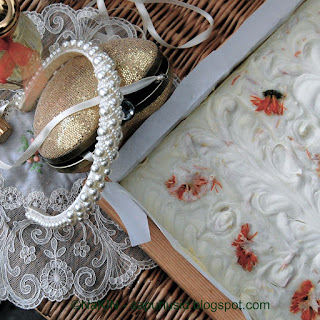 |
| That metal circle will be a great frame for a wedding picture of the kids. I have just the right photo for it but need to photoshop it to fit. I also dried some of my Hollyhock. |
I chose Comfrey, since I have quite a bit of it already dried and still a lot left in the allotment garden. I think maybe I read that Cocobong has used that and gotten a good green, but I'm not sure, it might have been nettle. I know that I have read that Parsley is supposed to give a good green. I tried to put that into oil. Do not do that. It's completely pointless. So now I'm drying some and I will try to put that into the water for a soap sometime.
But back to Comfrey. I have some of that in oil and also some that I simply dried. Since the infused oil isn't particularly green I put some crushed dried leaves into the lye water and let it sit for a while and it did turn a bit green, but not a lot. So I decided that I would leave the leaves in and attempt to make them smaller with the stick blender. Which I did and it worked fine. I don't usually like to leave flecks in the soap if I can help it, but if I hadn't there wouldn't have been much colour at all.
Since I had just bought some patchouli EO I decided to use that for the first time along with some Bergamot and Lemongras EO's. I have to admit that I wasn't sure what Patchouli was like because I have never had it. It is very Hippy to me. Reminiscent of the seventies. Which is good. A bit masculine also, and that is good since I haven't done a masculine fragrance in a long time.
I did a very simple soap.
Coconut oil 30% 150 g / 5.3 oz
Olive oil 40% 200 g / 7 oz
Soybean oil 25% 125 g/ 4.4 oz
Cocoa butter 6% 30 g / 1 oz
Water 38% 190g / 6.8 oz
Lye 72g / 2.5 oz
5% SF.
So the soap wasn't particularly green at first, but when I cut it it was this beautiful grass green. Alas, it has now turned olive green. A nice olive, but that green was amazing. How I miss it! But these are perfect soaps to give as a gift to a few guys that I have been working with. There are a few women in that group also, so I now am thinking up a recipe for a pink soap using my Rumex oil for the colour.
.







